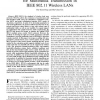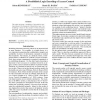SEC
2000
14 years 3 months ago
2000
: The development of complex access control architectures raises the problem of their management. In this article, we describe an architecture providing packet filters configuratio...
SEC
2000
14 years 3 months ago
2000
: Role-based access control associates roles with privileges and users with roles. Changes to these associations are infrequent and explicit. This may not reflect business requirem...
IWFM
2000
14 years 3 months ago
2000
Security services in a multi-user environment are often based on access control mechanisms. Static of an access control policy can be formalised using abstract algebraic models. W...
DBSEC
2000
14 years 3 months ago
2000
Abstract At the start of its present term of office in 1997 the UK government published a planning document promising ubiquitous access to Electronic Health Records (EHRs) held wit...
IKE
2003
14 years 3 months ago
2003
We describe the design of an Access Control System using Web Services for information and content management. In this paper we described the solution for control mechanism of the ...
SEC
2004
14 years 3 months ago
2004
Business Processes for Web Services (BPEL4WS) are the new paradigms for lightweight enterprise integration. They cross organizational boundaries and are provided by entities that s...
PDCN
2004
14 years 3 months ago
2004
IEEE 802.11, the standard of wireless local area networks (WLANs), allows the coexistence of asynchronous and time-bounded traffic using the distributed coordination function (DCF)...
FLAIRS
2003
14 years 3 months ago
2003
This paper proposes a modelling of information security policies in the framework of possibilistic logic. Our modelling is based on the concept of roles associated with users. Acc...
ISSA
2004
14 years 3 months ago
2004
Web Services technology enables organisations to exploit software as a service. Services are accessed by method invocations. Method interfaces are described and published, and may...
ISSA
2004
14 years 3 months ago
2004
Mobile devices, such as mobile phones, are becoming multi-purpose devices. These devices are capable of storing data as well as running custom applications. As more people adopt t...



